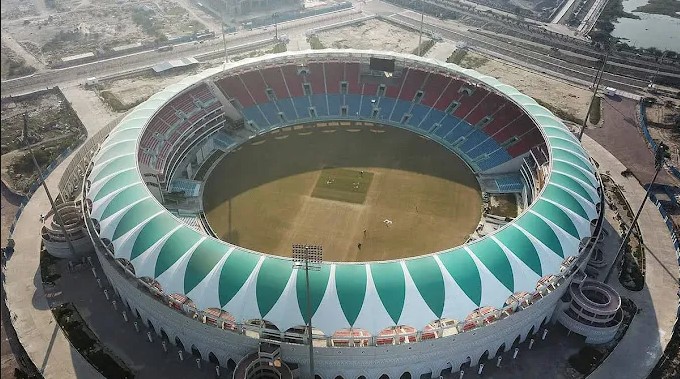Lucknow Stadium: Cricket in India is more than just a sport—it’s a passion, a culture, and an institution. Among the various cricket grounds in the country, Lucknow’s Bharat Ratna Shri Atal Bihari Vajpayee Ekana Cricket Stadium stands out as a modern, world-class venue. Known for its impressive seating capacity, advanced facilities, and excellent pitch conditions, one of the key features that impact the dynamics of the game is the boundary length. In this article, we’ll delve into the boundary dimensions of the stadium, how they influence the game, and compare them with other famous cricket grounds.
Table of Contents
1. Lucknow Stadium: Overview of the Ekana Cricket Stadium
Lucknow Stadium: The Ekana Cricket Stadium is located in the heart of Lucknow, Uttar Pradesh. Established in 2017, the stadium is named after India’s former Prime Minister, Atal Bihari Vajpayee, and has become a hub for international cricket in the region. With a seating capacity of 50,000 spectators, it ranks among the largest cricket stadiums in India.
Lucknow Stadium: Apart from hosting domestic and international cricket matches, the Ekana Stadium is known for its state-of-the-art facilities and its role in promoting cricket in northern India. The stadium has already hosted several high-profile matches, including IPL games, and continues to gain recognition.
2. Boundary Dimensions of the Ekana Stadium
One of the most important aspects of a cricket stadium is its boundary length, which can significantly affect the outcome of a match. At the Ekana Cricket Stadium, the boundary dimensions are designed to be competitive but also challenging for the players.
Straight Boundaries:
The straight boundaries at the Ekana Stadium are approximately 70 meters from the center of the pitch. This distance is quite common in many international stadiums but can be considered on the longer side when compared to other cricket grounds in India.
Square Boundaries:
Lucknow Stadium: The square boundaries, which are measured from the pitch towards the boundaries at both ends, are also about 70 meters. This makes the playing field relatively symmetrical, with no drastic differences between the length of straight and square boundaries.
Impact on Play:
Lucknow Stadium: Longer boundary lengths, such as those at Ekana Stadium, are generally considered beneficial to bowlers. It becomes harder for batsmen to clear the ropes, and therefore, matches often see more calculated risks from the batsmen, who have to work harder to score boundaries. This can lead to lower-scoring games, giving bowlers more control over the match.
Lucknow Stadium: Additionally, the large dimensions of the ground can affect fielding strategies, with outfielders needing to cover greater distances to stop boundaries. This increases the physical demands on fielders and can result in more exciting fielding performances.
3. Boundary Comparison with Other Famous Cricket Stadiums
Lucknow Stadium: When it comes to boundary lengths, the Ekana Stadium is not unique, but it stands out due to its modern design and large dimensions. Let’s take a closer look at how its boundary lengths compare to other notable cricket grounds.
Wankhede Stadium (Mumbai)
- Straight Boundaries: 70 meters
- Square Boundaries: 70 meters
- General Impact: Wankhede has similar boundary lengths to the Ekana Stadium, which ensures a fair balance between batting and bowling. The shorter boundaries in many Indian grounds make it easier for batsmen to score, but the large dimensions at both Ekana and Wankhede often challenge this.
Eden Gardens (Kolkata)
- Straight Boundaries: 65 meters
- Square Boundaries: 70 meters
- General Impact: Eden Gardens has relatively shorter straight boundaries but comparable square boundaries. The stadium is famous for its electrifying atmosphere, and the slightly shorter straight boundaries can sometimes make it a high-scoring ground.
Melbourne Cricket Ground (MCG)
- Straight Boundaries: 70 meters
- Square Boundaries: 70 meters
- General Impact: The MCG is an international standard ground with boundary lengths similar to those at Ekana. Its larger boundary lengths, particularly in both straight and square areas, make it more challenging for batsmen, creating competitive matches.
Table Comparison: Boundary Dimensions of Prominent Stadiums
| Stadium Name | Straight Boundaries | Square Boundaries | Overall Impact on Gameplay |
|---|---|---|---|
| Ekana Cricket Stadium (Lucknow) | 70 meters | 70 meters | Challenging for batsmen; favors bowlers |
| Wankhede Stadium (Mumbai) | 70 meters | 70 meters | Balanced ground; good competition for both |
| Eden Gardens (Kolkata) | 65 meters | 70 meters | High-scoring potential; batsmen-friendly |
| Melbourne Cricket Ground (MCG) | 70 meters | 70 meters | Fair play; more favorable for bowlers |
4. Why Boundary Lengths Matter in Cricket
Lucknow Stadium: The length of the boundary in a cricket stadium can significantly alter the outcome of a match. Shorter boundaries often lead to higher scoring, as batsmen have less distance to cover to hit a six. On the other hand, longer boundaries, like those at Ekana, require more power and precision from batsmen to clear the ropes. This often leads to more strategic batting and challenging field placements.
Here’s how boundary lengths affect key aspects of the game:
Batting:
Lucknow Stadium: Batsmen need to hit the ball harder and more precisely to clear long boundaries, making it more difficult to score quick runs. Longer boundaries tend to reduce the frequency of sixes, but they also reward batsmen who can hit the ball with more force and placement.
Bowling:
Lucknow Stadium: Bowlers benefit from longer boundaries as they have more room for error. A miss-hit shot is less likely to result in a six. As a result, bowlers can be more aggressive with their line and length, as the larger ground gives them more room to defend their deliveries.
Fielding:
Lucknow Stadium: Fielders have to cover more ground, making the fielding positions more important. On longer grounds, outfielders often need to cover greater distances to stop boundaries, adding to the physical intensity of the game.
The Bharat Ratna Shri Atal Bihari Vajpayee Ekana Cricket Stadium in Lucknow is a world-class facility with boundary dimensions that provide a fair and competitive playing field for both batsmen and bowlers. With straight and square boundaries at 70 meters, it challenges batsmen to be more strategic in their shot selection, while rewarding bowlers with more margin for error. This boundary length is in line with international standards and ensures that the game remains competitive, fast-paced, and thrilling for fans.
As the stadium continues to host both domestic and international events, its boundary dimensions will continue to play an integral role in shaping cricket matches, offering an exciting challenge for players and entertainment for spectators.

